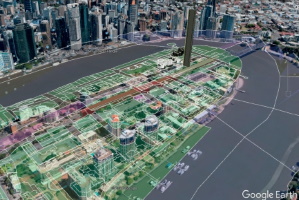

FIG Commission 3 - Spatial Information Management |
||||||||
 |
||||||||
Working Group - Joint Commission 3 and 7
|
||||||||
During the recent years 3D Cadastre has matured. The increasing complexity of infrastructures and densely built-up areas require a proper registration of the legal status (private and public), which can be provided only to a limited extent by the existing 2D cadastral registrations. Addressing this challenge has been the main goal of the International Federation of Surveyors (FIG) joint commission 3 ‘Spatial Information Management’ and commission 7 ‘Cadastre and Land Management’ Working Group on 3D Cadastres. The FIG Working Group uses the concept of 3D Cadastres with 3D parcels in the broadest possible sense: 3D parcels include land and water spaces, both above and below surface. The level of sophistication of a 3D Cadastre in a specific country will in the end be based on the user needs, land market requirements, legal framework, and technical possibilities.
In the foreword of the FIG Publication ‘Best Practices 3D Cadastres’, FIG Past President Chryssy Potsiou comments that “we, as geo-information professionals, vendors, providers, managers, professionals as well as academics and researchers, are expected to develop services and tools to deliver administrative, economic and social benefits. Our colleagues, representatives of business, academia and public administration; managers of geodata from all over the world; young entrepreneurs and creative minds; all are working toward the same goal, trying to increase the “value” of geodata for the people. They do so in order to get more benefit, more transparency, more safety, more environmental quality, more growth, more fairness, more efficiency in governance of urban areas, more smart cities. No reality has a more direct bearing on the subject of 3 dimensional geo-information and cadaster than the growth of large cities, especially in the developing countries of the world, and especially in the phenomenon of the mega cities.”
As cities grow they grow vertically as well as horizontally thereby introducing the element of the third dimension. Recent innovative thinking has introduced the concept of a multidimensional multipurpose land information system. It is a logical extension of the 3D cadastre concept, by adding the time dimension to the equation. In a discussion of “cost effectiveness” one must consider time, that 4th dimension that we speak of. In time, we are usually referring to land titles history and time-sharing rights, or how the shape and size of land parcels and cadastral objects change over time, but it is also a matter of time-cost in the construction of the cadastre, as well as the time/property value relationship. As the great cities of the world become mega, the value of land and its improvements grow as well. Thus the time/value relationship and its impact on land administration become central elements, and the need for continuing research on fundamental policy issues of technical administrative, legal and financial aspects of land administration will grow.
The on-going process of improving land administration systems is crucial. It responds to the need for international research in building effective land administration infrastructures with modern information technology that will support the 2030 global policy goals for sustainable development. Reference: Best Practices 3D Cadastres - Extended version, Editor: Peter van Oosterom, International Federation of Surveyors, Copenhagen, Denmark, March 2018 (ISBN 978-87- 92853-64-6, ISSN: 2311-8423)
|
Prof. Peter van Oosterom, the Netherlands
|
Prof. Alias Abdul Rahman, Malaysia |
What we are working on -
|
 |